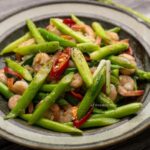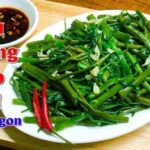Preparing Ingredients is Key
The key to a successful stir-fry is in the preparation. Stir-frying requires quick movements, so inadequate preparation will impact the quality of your dish. Here are some basic steps to prepare your ingredients before you start stir-frying:
– Choose fresh ingredients: Ensure your ingredients are fresh and of good quality. Process them promptly to maintain freshness. For frozen foods, allow them to thaw evenly before cooking to avoid cooling down the wok.

The right oil temperature is crucial for a tasty stir-fry
– Wash all your vegetables, fruits, and herbs under cold running water to remove dirt and impurities.
– Perform basic preparation techniques such as peeling, chopping, slicing, etc., on ingredients like carrots, tomatoes, celery, onions, eggplants, and mushrooms.
– Cut your ingredients into uniform sizes: As stir-frying can easily lead to uneven cooking, ensuring that your ingredients are evenly sized will help them cook uniformly and absorb flavors better.
– Prepare your spices and seasonings in advance: Have ingredients like minced garlic, chopped onions, chili, ginger, cinnamon leaves, pepper, salt, sugar, and soy sauce ready to use during cooking without interruption, as stir-frying requires speed.
– Consider how to combine your ingredients for a balanced and flavorful stir-fry.
– Arrange your prepared ingredients in separate bowls for easy access while cooking.

The secret to a delicious stir-fry
Choose the Right Wok
Using a wok that is too large or too small will impact the taste of your stir-fry. A large wok may cause your food to burn or become too salty, while a small wok can lead to uneven cooking. Opt for a wok with a thick bottom and non-stick properties to ensure even heat distribution and prevent sticking.
Heat Your Oil
For a tasty stir-fry, heat your oil in the wok before adding any ingredients. Ensure the oil is hot enough to release the aroma of ingredients like garlic and onions, which enhance the flavor of your dish. Adding these ingredients too early will cause them to turn soggy and lose their fragrance.
The Order of Ingredients Matters
The sequence in which you add your ingredients is crucial to creating a delicious stir-fry. Professional chefs understand that each ingredient has a unique cooking time and requires careful handling. Add ingredients that take longer to cook first, followed by quicker-cooking ones. Continuously stir your ingredients during cooking to ensure even cooking and to retain the freshness of each component.
Adjust Your Heat and Cooking Time
Heat control is vital in stir-frying. High heat can help ingredients retain their crispness and natural flavors, but it’s important to adjust the heat to prevent burning or overcooking. Many people stir-fry with a gentle hand and low heat, which can lead to prolonged cooking times and a sour taste due to extended simmering. Experienced chefs often time their stir-frying to avoid overcooking, which can dry out the dish, and undercooking, which doesn’t allow enough time for flavors to infuse.
Combine Spices and Sauces
To create a tasty stir-fry, chefs often combine spices and seasonings into a sauce. This saves time during cooking, as you don’t have to add each ingredient separately, ensuring a more consistent dish. Using a sauce also allows you to work quickly and efficiently, as you can stir and mix more effectively than when using dry spices.
Finally, once your stir-fry is cooked, add fresh herbs like scallions, coriander, mint, peppercorns, and basil at the very end to give your dish a fresh and flavorful finish.
“A Refreshing Treat: Green Mango and Jellyfish Salad.”
Here’s a mouth-watering twist on a classic Vietnamese dish – Green Mango and Jellyfish Salad. This unique combination of sweet and tangy flavors is sure to tantalize your taste buds and keep you coming back for more. With its refreshing and exotic appeal, this salad is the perfect way to spice up your regular meal routine.



































